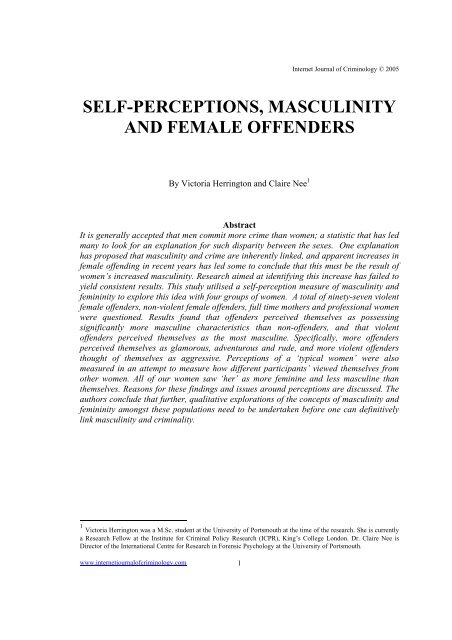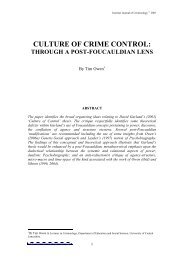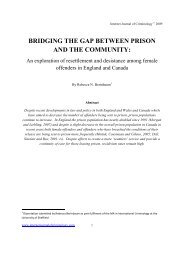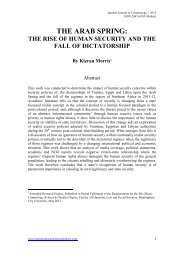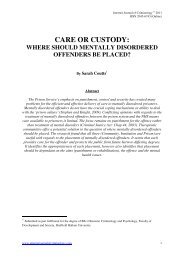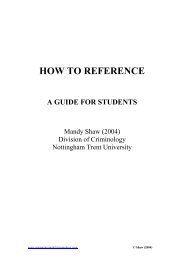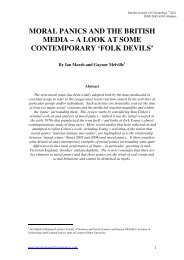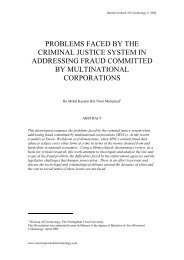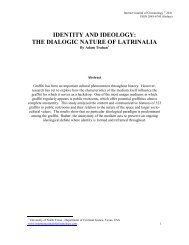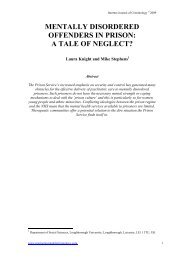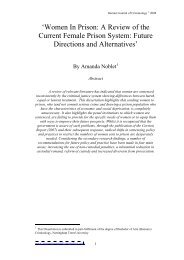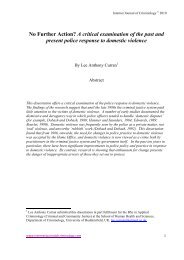self-perceptions, masculinity and female offenders - Internet Journal
self-perceptions, masculinity and female offenders - Internet Journal
self-perceptions, masculinity and female offenders - Internet Journal
Create successful ePaper yourself
Turn your PDF publications into a flip-book with our unique Google optimized e-Paper software.
www.internetjournalofcriminology.com<br />
1<br />
<strong>Internet</strong> <strong>Journal</strong> of Criminology © 2005<br />
SELF-PERCEPTIONS, MASCULINITY<br />
AND FEMALE OFFENDERS<br />
By Victoria Herrington <strong>and</strong> Claire Nee 1<br />
Abstract<br />
It is generally accepted that men commit more crime than women; a statistic that has led<br />
many to look for an explanation for such disparity between the sexes. One explanation<br />
has proposed that <strong>masculinity</strong> <strong>and</strong> crime are inherently linked, <strong>and</strong> apparent increases in<br />
<strong>female</strong> offending in recent years has led some to conclude that this must be the result of<br />
women’s increased <strong>masculinity</strong>. Research aimed at identifying this increase has failed to<br />
yield consistent results. This study utilised a <strong>self</strong>-perception measure of <strong>masculinity</strong> <strong>and</strong><br />
femininity to explore this idea with four groups of women. A total of ninety-seven violent<br />
<strong>female</strong> <strong>offenders</strong>, non-violent <strong>female</strong> <strong>offenders</strong>, full time mothers <strong>and</strong> professional women<br />
were questioned. Results found that <strong>offenders</strong> perceived themselves as possessing<br />
significantly more masculine characteristics than non-<strong>offenders</strong>, <strong>and</strong> that violent<br />
<strong>offenders</strong> perceived themselves as the most masculine. Specifically, more <strong>offenders</strong><br />
perceived themselves as glamorous, adventurous <strong>and</strong> rude, <strong>and</strong> more violent <strong>offenders</strong><br />
thought of themselves as aggressive. Perceptions of a ‘typical women’ were also<br />
measured in an attempt to measure how different participants’ viewed themselves from<br />
other women. All of our women saw ‘her’ as more feminine <strong>and</strong> less masculine than<br />
themselves. Reasons for these findings <strong>and</strong> issues around <strong>perceptions</strong> are discussed. The<br />
authors conclude that further, qualitative explorations of the concepts of <strong>masculinity</strong> <strong>and</strong><br />
femininity amongst these populations need to be undertaken before one can definitively<br />
link <strong>masculinity</strong> <strong>and</strong> criminality.<br />
1 Victoria Herrington was a M.Sc. student at the University of Portsmouth at the time of the research. She is currently<br />
a Research Fellow at the Institute for Criminal Policy Research (ICPR), King’s College London. Dr. Claire Nee is<br />
Director of the International Centre for Research in Forensic Psychology at the University of Portsmouth.
Introduction<br />
Gender <strong>and</strong> Crime<br />
www.internetjournalofcriminology.com<br />
2<br />
<strong>Internet</strong> <strong>Journal</strong> of Criminology © 2005<br />
Until recently, academic debate has generally accepted that crime <strong>and</strong> criminality are the<br />
domain of the male (Campbell, 2002; Heidensohn, 1994; Leonard, 1982), a view<br />
endorsed by official statistics <strong>and</strong> <strong>self</strong> report studies, which have long indicated that men<br />
are more likely than women to be both the perpetrators <strong>and</strong> the victims of a wide range of<br />
criminals acts (Home Office, 2002; Flood-Page et al., 2000; White <strong>and</strong> Kowalski, 1994).<br />
Equally it has become generally accepted that women commit a small share of all crimes,<br />
which are less serious <strong>and</strong> less professional in nature, resulting in their smaller<br />
representation within the criminal justice system (Heidensohn, 1994). This suggests that<br />
gender may be of greater statistical significance in differentiating between criminals <strong>and</strong><br />
non-criminals than any other characteristic (Worrall, 2001; Morris, 1987; Stoll, 1974).<br />
Recent years have seen a substantial increase in the number of women coming into<br />
contact with the criminal justice system in the U.K., <strong>and</strong> in particular an increase in the<br />
number of women incarcerated. Figures from the Home Office <strong>and</strong> Her Majesty' Prison<br />
Service indicate a rise of 15% in the number of women incarcerated between 2001 <strong>and</strong><br />
2002, compared to an increase of 6% for men (cited in Fawcett Society, 2003). Despite<br />
such increases, the comparably small number of women within the criminal justice
www.internetjournalofcriminology.com<br />
3<br />
<strong>Internet</strong> <strong>Journal</strong> of Criminology © 2005<br />
system continues today. 2 Explanations for this have typically come from one of two<br />
st<strong>and</strong>points: That women simply commit less crime, or that women commit as much<br />
crime as men but that this remains hidden (Pollock, 1950). Whilst the latter st<strong>and</strong> has<br />
found some empirical support - that women are treated more leniently by courts for<br />
example (Box, 1983), most research fails to find this to be the case (Hedderman <strong>and</strong><br />
Gelsthorpe, 1997) <strong>and</strong> suggests that the use of severe sentences, such as imprisonment,<br />
may actually be increasing disproportionately for women against the rate of use for men<br />
(Hedderman, 2003). Much research accepts therefore that women commit significantly<br />
less crime than men (Kruttschnitt et al., 2002), that their offences are typically less<br />
serious in nature <strong>and</strong> that their criminal careers are shorter (Fawcett Society, 2003;<br />
Hedderman, 2003). Searches for an explanation for this disparity have been numerous,<br />
although one has remained particularly popular with the media, general public <strong>and</strong> the<br />
scientific community. This theory highlights a link between crime <strong>and</strong> <strong>masculinity</strong>. 3<br />
Since the early days of criminology, when theoretical debate was dictated from a<br />
predominately biological perspective, attempts have been made to establish a link<br />
between the physiological characteristics of an individual <strong>and</strong> their propensity to commit<br />
2 Many have comprehensively reviewed official statistics concerning women within the criminal justice system <strong>and</strong><br />
examining the validity of arguments of increased <strong>female</strong> offending (see Deakin <strong>and</strong> Spencer, 2003; Home Office,<br />
2002). These discussions do not bear duplication here <strong>and</strong> the crux of this paper is in <strong>self</strong>-<strong>perceptions</strong>.<br />
3 It would be advisable to draw a theoretical distinction between sex <strong>and</strong> gender. Sex is usually regarded as having a<br />
biological origin, whereas gender can be regarded as less concrete a distinction where the terms ‘masculine’ <strong>and</strong><br />
‘feminine’ are afforded to behavioural characteristics which are commonly, although not exclusively associated with<br />
males <strong>and</strong> <strong>female</strong>s (Heidensohn, 1989). For the purpose of this discussion, ‘male’ <strong>and</strong> ‘<strong>female</strong>’ will be ascribed to<br />
those distinguished by their biological <strong>and</strong> sexual attributes, whereas the terms masculine <strong>and</strong> feminine will describe<br />
those traits, behaviours <strong>and</strong> characteristics that have been traditionally associated with males <strong>and</strong> <strong>female</strong>s respectively.
<strong>Internet</strong> <strong>Journal</strong> of Criminology © 2005<br />
crime. Such attempts concentrated upon finding a biological explanation for men’s<br />
criminality <strong>and</strong> led to the development of a theoretical link between <strong>masculinity</strong> <strong>and</strong><br />
crime. Proponents of this view believed that biological characteristics associated with<br />
being male - such as aggression <strong>and</strong> dominance - increased an individual’s tendency for<br />
criminality, <strong>and</strong> in particular for violence. Women were not frequently involved in crime<br />
<strong>and</strong> aggression therefore because they lacked these biologically masculine - <strong>and</strong> thus<br />
criminal- characteristics. Women were inherently passive <strong>and</strong> conservative, so less<br />
criminally capable than men whose criminality was a function of their biology<br />
(Lombroso <strong>and</strong> Ferrero, 1895). Women who did indulge in crime, were seen as non-<br />
<strong>female</strong> <strong>and</strong> inherently masculine (Carlen, 1985; Heidensohn, 1985); described as<br />
‘graceless, lumpish <strong>and</strong> uncouth’, they were seen to possess the physical traits likening<br />
them more to men than women (Cowie et al., 1968). Women’s apparent lack of<br />
criminality was further explained by a belief that criminal characteristics had been ‘bred<br />
out’ through a process of natural selection, with the more ‘manly’ <strong>female</strong>s (<strong>and</strong> thus those<br />
whose biology had made them more criminally inclined), failing to find sexual partners<br />
with whom to propagate their criminogenic tendencies (Lombroso <strong>and</strong> Ferrero, 1895).<br />
In more recent years, purely biological explanations for criminal behaviour have fallen<br />
out of favour, in part because of the difficulty accounting for the vast majority of males<br />
who did not offend 4 . Most recent research has developed around a socially orientated<br />
4 That said, the role of evolution has recently been revisited by Anne Campbell <strong>and</strong> colleagues (2001). Campbell has<br />
proposed that natural selection has resulted in differences in evolved levels of fear. In short, women are less frequently<br />
involved in crime because evolutionary pressure has resulted in their development of a lower threshold for fear <strong>and</strong><br />
more limited risk taking (Campbell, 2002; Campbell et al., 2001).<br />
www.internetjournalofcriminology.com<br />
4
www.internetjournalofcriminology.com<br />
5<br />
<strong>Internet</strong> <strong>Journal</strong> of Criminology © 2005<br />
framework, although a belief in the link between criminality <strong>and</strong> <strong>masculinity</strong> has<br />
persisted. Socialisation into sex-stereotypes is central to the gender <strong>and</strong> crime debate<br />
within this framework, with socialisation defined as the transmission of appropriate<br />
behaviours, roles, attitudes <strong>and</strong> beliefs from generation to generation (Weinreich, 1980).<br />
This theory supposes that gender is a highly significant factor in the upbringing of<br />
children, with differences found in the socialisation of boys <strong>and</strong> girls <strong>and</strong> stereotypical<br />
beliefs about gender appropriate behaviours for males <strong>and</strong> <strong>female</strong>s (Leventhal, 1977;<br />
Oakley, 1974, cited in Haralambos <strong>and</strong> Holborn, 1990). This is reflected in socialisation<br />
(Weinreich, 1980) <strong>and</strong> is responsible then for the (criminal) behaviour of males <strong>and</strong><br />
<strong>female</strong>s, rather than biologically determined sex differences (Omodei, 1981). Whereas<br />
<strong>female</strong> socialisation is thought to emphasise conformity, the deviant behaviour of males<br />
is tolerated <strong>and</strong> even condoned <strong>and</strong> excused (Heidensohn, 1989). Goals <strong>and</strong> behaviours<br />
encouraged for males are thought to have much in common with criminal activity<br />
(Dobash et al., 1995; Omodei, 1981), with personal characteristics encouraged through<br />
socialisation into the male gender role (such as aggression, being adventuresome <strong>and</strong><br />
tough) thought necessary for involvement in crime (Naffine, 1987; Eagly, 1987). Crime<br />
is seen as symbolically masculine - <strong>and</strong> <strong>masculinity</strong> as supplying the motive for crime<br />
(Naffine, 1987). The dividing line between the two is a thin one (Oakley, 1972).<br />
Taken to the logical conclusion, the more masculine an individual the more frequently<br />
involved in crime we might expect s/he will be - particularly with relation to violent<br />
offending which is thought to engender a greater degree of <strong>masculinity</strong>. Women who
www.internetjournalofcriminology.com<br />
6<br />
<strong>Internet</strong> <strong>Journal</strong> of Criminology © 2005<br />
offend are not ‘proper women’ (Worrall, 1990), <strong>and</strong> <strong>female</strong> aggression is often judged<br />
more harshly than aggression by males because it reflects a greater departure from <strong>female</strong><br />
social norms (Gelsthorpe, 2003; Paul <strong>and</strong> Baenninger, 1991). Violent women (in<br />
particular) must therefore be mentally ill or emulating men (Campbell, 1993), because<br />
simply, this is not how nice girls should behave (Batchelor, 2001).<br />
This argument suggests that <strong>female</strong> <strong>offenders</strong> must have been (wrongly) socialised into<br />
male gender roles. Some justification for this st<strong>and</strong> has been drawn from the belief that<br />
<strong>female</strong> offending has increased in t<strong>and</strong>em with the greater emancipation of women <strong>and</strong><br />
an apparent ‘masculinization’ of <strong>female</strong> behaviour in general during the 1970s Women’s<br />
Liberation Movement (Heidensohn, 1989; Adler, 1975; Simon, 1975). Increased<br />
offending was thought inevitable as barriers that protected male prerogatives broke down<br />
<strong>and</strong> socially defined gender roles became increasingly alike (Adler, 1977). Women’s<br />
increased involvement in crime was seen then as a function of them more frequently<br />
adopting traditionally masculine characteristics (Norl<strong>and</strong>, Wessel <strong>and</strong> Shover, 1981).<br />
Biological, socialisation <strong>and</strong> masculinization explanations of <strong>female</strong> offending all hold at<br />
their core that crime is a masculine activity <strong>and</strong> that by definition therefore, <strong>female</strong><br />
<strong>offenders</strong> must be more masculine. Whilst this may seem over simplistic, the notion has<br />
proven attractively straightforward <strong>and</strong>, for the media in particular, has proved to be a<br />
newsworthy explanation for even recent apparent increases in <strong>female</strong> offending.
www.internetjournalofcriminology.com<br />
7<br />
<strong>Internet</strong> <strong>Journal</strong> of Criminology © 2005<br />
(Batchelor, 2001; Batchelor, Burman <strong>and</strong> Brown, 2001). This research aimed to examine<br />
<strong>female</strong> offending <strong>and</strong> specifically the idea that <strong>female</strong> offending was linked to higher<br />
levels of <strong>masculinity</strong>.<br />
Previous Research<br />
Several empirical studies have been conducted looking at women’s <strong>masculinity</strong>, <strong>self</strong>-<br />
perceived or otherwise. Unfortunately few are recent <strong>and</strong> most have yielded limited or<br />
inconsistent support. Some indicate that <strong>self</strong>-reported possession of typically male traits<br />
increase an individual’s propensity to commit crime (Cullen, Golden <strong>and</strong> Cullen 1979;<br />
Eve <strong>and</strong> Edmonds, 1978; Shover, Norl<strong>and</strong> <strong>and</strong> Thornton, 1979; Widon, 1979), but others<br />
fail to find the <strong>female</strong> offender any more masculine in sex-role or attitude than non-<br />
<strong>offenders</strong>, <strong>and</strong> even to score higher on femininity measures than control groups (Simon<br />
<strong>and</strong> L<strong>and</strong>is, 1991; Naffine, 1987). The evidence is therefore ambiguous <strong>and</strong> there<br />
remains no clear-cut support for the notion that a woman’s increased <strong>masculinity</strong> leads to<br />
her criminality.<br />
Methodological variations might in part account for inconsistency in previous research<br />
findings. One problem associated with early studies had been a tendency to accept sex-<br />
stereotypes as reliably descriptive of males <strong>and</strong> <strong>female</strong>s with certain characteristics used<br />
to differentiate the sexes without documentation of the validity. As such many studies<br />
may have started out with faulty concepts of femininity <strong>and</strong> <strong>masculinity</strong> (Shover <strong>and</strong><br />
Norl<strong>and</strong>, 1978).
www.internetjournalofcriminology.com<br />
8<br />
<strong>Internet</strong> <strong>Journal</strong> of Criminology © 2005<br />
A second problem relates to the participants who were employed in the research. Here<br />
the issues are four-fold:<br />
• Small sample sizes were often used, sometimes with only 25 to 50 individuals<br />
involved (e.g. Leventhal 1977).<br />
• Participants were not always drawn from offender populations, with students -<br />
typically a highly selective group constituting the intellectually elite, socially<br />
aware <strong>and</strong> more politically liberal sections of society (Williams <strong>and</strong> Best, 1990) -<br />
used as a substitute (e.g. Eve <strong>and</strong> Edmonds, 1978).<br />
• Ages of participants varied significantly, ranging from groups of 10 year old<br />
children (e.g. Shover, Norl<strong>and</strong> <strong>and</strong> Thornton, 1979) to college students <strong>and</strong> adults<br />
(e.g. Cullen, Golden <strong>and</strong> Cullen, 1979).<br />
• There was a tendency to treat the <strong>female</strong> offending population homogenously,<br />
failing to draw distinctions between the perpetrators of theoretically different<br />
crimes (Daniel <strong>and</strong> Kashani, 1983).<br />
On this last point, it is important to appreciate that the motivation for offending is likely<br />
different for <strong>offenders</strong> committing different offence types. For example, property<br />
<strong>offenders</strong> are more likely driven by economic gain; violent <strong>offenders</strong> may be more<br />
motivated by expressive needs (Nee <strong>and</strong> Taylor, 2000; Campbell, 1993; Cornish <strong>and</strong><br />
Clarke, 1986). In terms of <strong>masculinity</strong>, one might hypothesise that violence <strong>and</strong><br />
aggression in particular require a greater degree of <strong>masculinity</strong>, certainly representing a<br />
greater departure from acceptable <strong>female</strong> behaviour (Gelsthorpe, 2003; Batchelor, 2001).<br />
One would expect then that violent offending be more prevalent among the more
exploratory.<br />
www.internetjournalofcriminology.com<br />
9<br />
<strong>Internet</strong> <strong>Journal</strong> of Criminology © 2005<br />
masculine <strong>female</strong> <strong>offenders</strong>. Whilst a violent / non-violent distinction might seem crude,<br />
it would be misguided to consider all <strong>female</strong> (or male) <strong>offenders</strong> as the same.<br />
The Present Investigation<br />
Building upon the <strong>masculinity</strong> concepts outlined earlier, this research investigated the<br />
argument that <strong>female</strong> <strong>offenders</strong> are more masculine in their attitudes <strong>and</strong> beliefs than<br />
their non-offending counterparts. It also set out to redress some of the methodological<br />
flaws outlined above. Self-<strong>perceptions</strong> of <strong>masculinity</strong> <strong>and</strong> femininity were collected from<br />
women convicted of criminal offences <strong>and</strong> from a control group of non-offending<br />
women. These two groups were sub-divided, allowing further comparison. The offender<br />
sample consisted of women convicted of traditionally masculine person-directed violent<br />
offences <strong>and</strong> women convicted of non-violent crimes. The non-offender group<br />
comprised women currently engaged in traditionally masculine professional roles <strong>and</strong><br />
those in the traditionally <strong>female</strong> role of full-time parenting. It would be misleading to<br />
represent the non-offending women as formal ‘control groups’, with socio-demographic<br />
differences not controlled for 5 .<br />
5 This was as a result of the small sample sizes recruited to this study. The scope of this research therefore remains
www.internetjournalofcriminology.com<br />
10<br />
<strong>Internet</strong> <strong>Journal</strong> of Criminology © 2005<br />
This was an exploratory study <strong>and</strong> while previous empirical research was ambiguous in<br />
its findings, theoretical explanations led us to expect that:<br />
• Women convicted of criminal offences would possess more of the characteristics<br />
traditionally associated with <strong>masculinity</strong>, <strong>and</strong> therefore score higher for<br />
<strong>masculinity</strong> than the non-offending women.<br />
• Within the offending population, women convicted of violent crimes would<br />
possess more of the characteristics traditionally associated with <strong>masculinity</strong>, <strong>and</strong><br />
therefore score higher for <strong>masculinity</strong> than non-violent <strong>offenders</strong>.
Method<br />
Participants<br />
www.internetjournalofcriminology.com<br />
11<br />
<strong>Internet</strong> <strong>Journal</strong> of Criminology © 2005<br />
Ninety-seven participants completed a short postal questionnaire <strong>and</strong> returned it for<br />
inclusion in the analysis. All <strong>female</strong> <strong>offenders</strong> involved in the research had been<br />
convicted of offences <strong>and</strong> were presently serving custodial sentences for their offence.<br />
They were identified <strong>and</strong> recruited with the assistance of prison governors <strong>and</strong> completed<br />
the questionnaire independently or with assistance of the researchers 6 . Professional<br />
women were recruited through the Human Resource (HR) departments of local<br />
employers, <strong>and</strong> full time parents were contacted with the assistance of parent <strong>and</strong> child<br />
organisations in the Portsmouth area. Again, questionnaires were completed<br />
independently or with our assistance during visits.<br />
Twenty-four participants were currently serving a prison sentence for a violent crime,<br />
including murder <strong>and</strong> armed robbery, <strong>and</strong> thirty-two women were serving a sentence for<br />
non-violent offences including burglary, theft <strong>and</strong> drug possession (N = 56 for offender<br />
sample). Twenty-seven of the non-offending sample were categorised as employed in<br />
professional occupations, <strong>and</strong> fourteen were full-time parents (N = 41 for non-offender<br />
sample). The ages of the sample ranged from 16 to 57 years old with an overall mean age<br />
of 30. Mean ages for each of the four groups were 25 for violent <strong>offenders</strong>, 29 for non-<br />
violent <strong>offenders</strong>, 30 for full time parents <strong>and</strong> 36 for professional women. Professional<br />
women were inevitably a little older because of the time needed to develop their career.
www.internetjournalofcriminology.com<br />
12<br />
<strong>Internet</strong> <strong>Journal</strong> of Criminology © 2005<br />
The majority of <strong>offenders</strong> were now single (n = 36), with most non-<strong>offenders</strong> in some<br />
form of a relationship (n = 28). Thirty-six women had no children still living at the<br />
family home. The remaining women had between one <strong>and</strong> three such dependants.<br />
Data collection instrument<br />
Self-perceived masculine <strong>and</strong> feminine characteristics were collected through the<br />
questionnaire. We wanted to know to what extent women considered themselves<br />
masculine or feminine. After collecting background data regarding demographic factors<br />
(age <strong>and</strong> marital status) <strong>and</strong> degree of criminal involvement, our questionnaire directed<br />
participants to tick off items from a list of st<strong>and</strong>ardised ‘masculine’ <strong>and</strong> ‘feminine’<br />
adjectives that applied to them. Secondly, they were asked to repeat this exercise on a<br />
second sheet, but this time in relation to those items they felt applied to a ‘typical’<br />
woman. The latter task was aimed to qualify the extent to which women saw their own<br />
profile deviating from their idea of ‘the norm’. We used lists of adjectives generated by<br />
Williams <strong>and</strong> Best (1990).<br />
Williams <strong>and</strong> Best (1990) had argued that sex-trait stereotypes were psychological<br />
characteristics or behavioural traits that were perceived to characterise one sex much<br />
more frequently than the other. Sex-trait stereotypes are paramount in the development of<br />
beliefs about appropriate behaviour for males <strong>and</strong> <strong>female</strong>s. Williams <strong>and</strong> Best (1990)<br />
argued that it is sex-trait stereotypes that are the essence of perceived <strong>masculinity</strong> <strong>and</strong><br />
6 All offender participants were aware that participation was voluntary <strong>and</strong> that participating would not have any<br />
positive or negative consequences for them regarding their sentence. Any woman that was interested in completing the
<strong>Internet</strong> <strong>Journal</strong> of Criminology © 2005<br />
femininity. Whilst there are other (Likert scale-type) measures available, we wanted to<br />
present a clear <strong>and</strong> simple check box instrument, <strong>and</strong> Williams <strong>and</strong> Best’s checklist -<br />
described below - seemed a useful <strong>and</strong> appropriate way to measure these <strong>perceptions</strong>.<br />
The ‘Adjective Checklist’ (AC) was developed using an original list of 300 adjectives<br />
from Gough <strong>and</strong> Heilbrun (1965), which were tested in 28 countries with a sample of<br />
2,800 participants. Participants were asked to consider each adjective <strong>and</strong> make a relative<br />
decision about whether it was generally said to be more frequently associated with men,<br />
women, or undifferentiated between the sexes. This resulted in a list of 57 adjectives<br />
highly associated with either men or women (Williams <strong>and</strong> Best, 1990).<br />
This list was adapted for use in the current investigation, with issues of cultural relevance<br />
<strong>and</strong> literacy addressed by removing adjectives the authors felt were associated with<br />
higher levels of educational attainment 7 , <strong>and</strong> in six cases replacing one word with another<br />
of the same meaning derived from the Oxford English Dictionary. Thirty-four adjectives<br />
were used, 17 highly associated with males <strong>and</strong> 17 with <strong>female</strong>s, as presented in Table 1.<br />
questionnaire did so, so we have no figures on response rates or if any declined to participate.<br />
7<br />
Figures from the Department of Education <strong>and</strong> Skills estimate that approximately half of all prisoners have severe<br />
problems with literacy (Sourced from DFES website, 2004).<br />
www.internetjournalofcriminology.com<br />
13
Table I. The Adjective Checklist-34 (AC - 34)<br />
MALE ADJECTIVES FEMALE ADJECTIVES<br />
Dominant Complaining<br />
Masculine Sympathetic<br />
Adventurous Warm<br />
Rude Nervous<br />
Assertive Glamorous<br />
Enterprising Obedient<br />
Boastful Soft-hearted<br />
Courageous Nagging<br />
Confident Affectionate<br />
Aggressive Attractive<br />
Reckless Gentle<br />
Daring Sentimental<br />
Tough Emotional<br />
Sensible Sensitive<br />
Rough Appreciative<br />
Logical Feminine<br />
Unemotional Moody<br />
www.internetjournalofcriminology.com<br />
14<br />
<strong>Internet</strong> <strong>Journal</strong> of Criminology © 2005<br />
The questionnaire therefore provided four scores for each participant, (2 masculine <strong>and</strong> 2<br />
feminine) out of a possible total of 17. These scores formed the basis of the <strong>masculinity</strong><br />
<strong>and</strong> femininity measurements, which were derived for each group by taking the mean<br />
score across the cases. In other words, <strong>masculinity</strong> <strong>and</strong> femininity were measured by
www.internetjournalofcriminology.com<br />
15<br />
<strong>Internet</strong> <strong>Journal</strong> of Criminology © 2005<br />
counting the total number of masculine <strong>and</strong> feminine characteristics checked by<br />
respondents.
Results<br />
Masculinity<br />
www.internetjournalofcriminology.com<br />
16<br />
<strong>Internet</strong> <strong>Journal</strong> of Criminology © 2005<br />
A two (<strong>masculinity</strong> score; femininity score) by four (group) ANOVA found that for<br />
<strong>perceptions</strong> of <strong>self</strong>, all women scored significantly higher on the femininity than the<br />
<strong>masculinity</strong> scale (F (1, 93) = 45.30 p
www.internetjournalofcriminology.com<br />
17<br />
<strong>Internet</strong> <strong>Journal</strong> of Criminology © 2005<br />
These data support our premise, with <strong>female</strong> <strong>offenders</strong> scoring higher on a measure of<br />
<strong>masculinity</strong> than their non-offending counterparts, <strong>and</strong> women imprisoned for violent<br />
offences reporting to possess more traditionally masculine characteristics than women<br />
imprisoned for non-violent crimes. Interestingly, a comparison of the two non-offender<br />
groups highlighted that professional women also perceived themselves to possess more<br />
traditionally masculine characteristics than full-time parents, although this was not<br />
statistically significant.<br />
Femininity<br />
Comparisons of femininity scores were also conducted, as some research had supported<br />
the possibility that low femininity scores could be as indicative of criminality as high<br />
<strong>masculinity</strong> scores (Widom, 1979). The two by four ANOVA detailed above had already<br />
indicated that all women had scored higher on a measure of femininity than <strong>masculinity</strong> –<br />
<strong>and</strong> in fact all women had checked an average of more than nine ‘feminine’<br />
characteristics – i.e. more than half of those presented. A one-way ANOVA looking at<br />
femininity revealed however that whilst non-violent <strong>offenders</strong> scored highest on <strong>self</strong>-<br />
rated femininity <strong>and</strong> professional women had the lowest average scores, these, did not<br />
differ significantly between the four groups of women. (F(3,93) = 0.62 p>0.05),<br />
Types of male <strong>and</strong> <strong>female</strong> characteristics<br />
The analysis thus far has examined differences between the groups in terms of the total<br />
number of male <strong>and</strong> <strong>female</strong> characteristics that participants’ perceived themselves to
<strong>Internet</strong> <strong>Journal</strong> of Criminology © 2005<br />
have. We turn now to examine the types of male <strong>and</strong> <strong>female</strong> characteristics each group<br />
had assigned themselves. A number of chi-square tests 8 highlighted that a significantly<br />
higher proportion of <strong>offenders</strong> than non-<strong>offenders</strong> perceived themselves as possessing the<br />
adventurous (χ 2 = 7.98, df 3, p
www.internetjournalofcriminology.com<br />
19<br />
<strong>Internet</strong> <strong>Journal</strong> of Criminology © 2005<br />
typicality (F(1,91) = 28.78 p
Discussion <strong>and</strong> Conclusions<br />
www.internetjournalofcriminology.com<br />
20<br />
<strong>Internet</strong> <strong>Journal</strong> of Criminology © 2005<br />
Before embarking upon a discussion of the results <strong>and</strong> their implications, it is worth<br />
remembering that sample sizes involved here were small, precluding the matching of<br />
samples on demographic variables such as age, ethnicity <strong>and</strong> socio-economic<br />
background. Whilst this may limit generalisations from this work, <strong>and</strong> affect the<br />
robustness of the statistical findings; both criticisms of previous research in this area; our<br />
study did result in the predicted findings <strong>and</strong> a number of conclusions can be drawn.<br />
Although, as expected from an exploratory study of this type, findings should be regarded<br />
as indicative only.<br />
Firstly, the women incarcerated for criminal offences in our study perceived themselves<br />
to possess more characteristics regarded as traditionally ‘masculine’ than their non-<br />
offending counterparts, especially those imprisoned for violent crimes. However, this<br />
correlation does not signify causation. Alternative explanations are numerous <strong>and</strong> include<br />
the possibility that higher levels of <strong>self</strong>-perceived <strong>masculinity</strong> among <strong>female</strong> <strong>offenders</strong>,<br />
particularly violent <strong>female</strong> <strong>offenders</strong>, is a function of criminal identity exacerbated, or<br />
wholly caused by, the experience of incarceration. That is, perceiving one<strong>self</strong> as<br />
adventurous or rude may be the result of involvement in crime <strong>and</strong>/or incarceration -<br />
rather than the cause of it. Certainly in light of <strong>offenders</strong>’ <strong>perceptions</strong> of both <strong>self</strong> <strong>and</strong><br />
typical women as more masculine than non-<strong>offenders</strong>’, the possibility that something<br />
unique to the prison experience affected <strong>perceptions</strong> should be considered.
www.internetjournalofcriminology.com<br />
21<br />
<strong>Internet</strong> <strong>Journal</strong> of Criminology © 2005<br />
The concept of desirability may also explain a greater sense of ‘<strong>masculinity</strong>’ amongst the<br />
<strong>offenders</strong>. Notions of social desirability bias lead us to suppose that more respondents<br />
want to describe themselves in positive rather than negative terms. Interpretation of the<br />
AC-34 in terms of desirability might lead to women wishing to report the feminine trait<br />
of ‘attractiveness’, but not ‘complaining’. Likewise for masculine characteristics,<br />
women may wish to see themselves as ‘confident’, but not ‘boastful’. Somewhat<br />
intertwined is the notion of trait desirability <strong>and</strong> subculture. Women within the offending<br />
population might view traits such as adventurousness <strong>and</strong> daring more desirably than full<br />
time mums; as a result of their cultural milieu <strong>and</strong> because these arguably represent the<br />
characteristics necessary to survive <strong>and</strong> succeed in their lifestyle. Equally, violent<br />
<strong>offenders</strong> may perceive themselves aggressive because this characteristic is more<br />
desirable within their particular subculture. Both <strong>offenders</strong> <strong>and</strong> professional women may<br />
perceive themselves as daring, due perhaps to their break from the more traditional<br />
<strong>female</strong> norm of full time parenting.<br />
Trait comprehension is another point worth consideration here. Efforts were made to<br />
ensure that all adjectives were culturally relevant <strong>and</strong> unambiguous; although Laider <strong>and</strong><br />
Hunt’s work with girl gang members has highlighted that certain terms might be highly<br />
gendered - meaning different things to males <strong>and</strong> <strong>female</strong>s. They found that ‘respect’<br />
could not be understood solely in masculine terms of power <strong>and</strong> control <strong>and</strong> that among<br />
the women they interviewed it was associated with the pursuit of respectability - an<br />
important
www.internetjournalofcriminology.com<br />
22<br />
<strong>Internet</strong> <strong>Journal</strong> of Criminology © 2005<br />
dimension of ‘being feminine’ (Laider <strong>and</strong> Hunt, 2001: 664). One might suppose that<br />
this could also be the case with our different groups of women discussed above:<br />
Toughness for one group might mean physical strength or resolve, for another it might<br />
have emotional connotations.<br />
Whether women actually possess these perceived characteristics to such differing<br />
degrees; are consciously conforming to their subcultural stereotypes; desire certain<br />
characteristics above others; or simply underst<strong>and</strong> them to mean different things; remains<br />
an open question. Despite this, our findings st<strong>and</strong>: Our women <strong>offenders</strong> perceived<br />
themselves to be significantly different to the non-<strong>offenders</strong> using more adjectives<br />
defined as masculine.<br />
Interestingly, all women scored highly on our femininity measure too, which leads us to<br />
conclude that <strong>female</strong> <strong>offenders</strong> – <strong>and</strong> violent <strong>offenders</strong> in particular – perceived<br />
themselves as both highly masculine <strong>and</strong> highly feminine. High <strong>masculinity</strong> <strong>and</strong><br />
femininity is termed ‘<strong>and</strong>rogyny’. Traditional <strong>and</strong>rogyny is supposed to combine the<br />
positive traits of <strong>masculinity</strong> <strong>and</strong> femininity – taking the best from both worlds. However,<br />
it is equally likely that an <strong>and</strong>rogynous individual take on the negative traits of<br />
<strong>masculinity</strong> <strong>and</strong> femininity; in the words of Brenda Woodhill;<br />
Nowhere in the literature has it been suggested that humans never behave in an<br />
undesirable fashion, therefore the <strong>and</strong>rogynous personality may also include
www.internetjournalofcriminology.com<br />
23<br />
<strong>Internet</strong> <strong>Journal</strong> of Criminology © 2005<br />
competence in undesirable behaviours or vices. For example a positive<br />
<strong>and</strong>rogynous person may demonstrate high levels of independence (m+),<br />
compassion (f+), ambition (m+) <strong>and</strong> tolerance (f+), where as a negatively<br />
<strong>and</strong>rogynous person may demonstrate high levels of submissiveness (f -) <strong>and</strong><br />
<strong>self</strong>ishness (m -), or be temperamental (f -) <strong>and</strong> aggressive (m -). (Woodhill,<br />
2003: xx).<br />
If we consider our results, women <strong>offenders</strong> were more rude, daring (along with<br />
professional women) <strong>and</strong> aggressive (for violent <strong>offenders</strong>), each of which might be<br />
interpreted as among the more negative masculine characteristics. Our <strong>offenders</strong> were<br />
also more glamorous – an arguably positive feminine trait; <strong>and</strong> more adventurous – a<br />
positive masculine characteristic. In terms of <strong>and</strong>rogyny then, our <strong>offenders</strong> had drawn<br />
more greatly upon the negative masculine characteristics than the positive. Woodhill<br />
notes that a negatively <strong>and</strong>rogynous individual will have a bigger repertoire of<br />
undesirable behaviours from which to choose a response (Woodhill, 2003: xx), with both<br />
masculine <strong>and</strong> feminine responses available to them. The significant differences between<br />
the groups of women that we have highlighted in this paper certainly suggest that our<br />
<strong>offenders</strong> may have chosen more frequently from the negatively masculine list than non-<br />
<strong>offenders</strong> – perhaps accounting in part for their current situation. In this sense then, one<br />
cannot conclude that <strong>female</strong> <strong>offenders</strong> are simply more masculine although they do<br />
perceive themselves to possess more masculine characteristics. The positivity <strong>and</strong><br />
negativity of each characteristic - together with the behaviour likely to be displayed as a<br />
result <strong>and</strong> any mitigating responses from other (positive <strong>and</strong>/or feminine) characteristics<br />
also held - must be considered.
www.internetjournalofcriminology.com<br />
24<br />
<strong>Internet</strong> <strong>Journal</strong> of Criminology © 2005<br />
In conclusion then, whilst this study has generated the findings we predicted; that <strong>female</strong><br />
<strong>offenders</strong>, in particular violent <strong>female</strong> <strong>offenders</strong>, would perceive themselves as more<br />
‘masculine’ than non-<strong>offenders</strong>; the next step should involve in-depth qualitative<br />
explorations of what comprises <strong>masculinity</strong> <strong>and</strong> femininity today, with characteristics<br />
considered more in terms of their positiveness <strong>and</strong> negativeness. Are <strong>offenders</strong> more<br />
<strong>and</strong>rogynous, but draw more on the negativity of <strong>masculinity</strong> <strong>and</strong> femininity? Do non-<br />
offending women draw more on the positivity? Or do they have fewer (masculine)<br />
responses available to them, drawing instead on negative <strong>female</strong> attributes such as<br />
submissiveness? A better appreciation of how men view themselves would also<br />
obviously further our knowledge in the whole field of enquiry. Building on the findings<br />
here, a deeper underst<strong>and</strong>ing of how the individual currently defines themselves in terms<br />
of <strong>masculinity</strong> <strong>and</strong> femininity will help us to tease out any meaningful <strong>and</strong> useful links<br />
between <strong>masculinity</strong>, femininity <strong>and</strong> criminality. In turn, this may well add to our<br />
growing knowledge about gender issues in the aetiology of crime.
References<br />
www.internetjournalofcriminology.com<br />
25<br />
<strong>Internet</strong> <strong>Journal</strong> of Criminology © 2005<br />
Adler, F. (1975) Sisters in crime: The rise of the new <strong>female</strong> criminal. New York:<br />
McGraw-Hill<br />
Adler, F. (1977) ‘The interaction between women’s emancipation <strong>and</strong> <strong>female</strong> criminality:<br />
A cross-cultural perspective’, International <strong>Journal</strong> of Criminology <strong>and</strong> Penology, 5:<br />
101-112<br />
Batchelor, S. (2001) ‘The myth of girl gangs’, Criminal Justice Matters. Spring, 43: 26-<br />
27<br />
Batchelor, S., Burman, M. <strong>and</strong> Brown, J. (2001) ‘Discussing Violence: Let’s hear it from<br />
the girls’, Probation <strong>Journal</strong>, Vol 48(2): 125-134<br />
Box, S. (1983) Power, Crime <strong>and</strong> Mystification. London: Tavistock<br />
Brearley, N. (1996) ‘Law <strong>and</strong> order in Engl<strong>and</strong> <strong>and</strong> Wales’, in Lancaster, S. (ed)<br />
Development in politics: An annual review vol 7. Ormskirk: Causeway Press<br />
Brehm, S. <strong>and</strong> Kassin, S. (1993) Social Psychology. Boston: Houghton Mifflin Company<br />
Campbell, A. (2002) A mind of her own: The evolutionary psychology of women.<br />
Oxford: Oxford University Press<br />
Campbell, A. (1993) Men, women <strong>and</strong> aggression. New York: Basic Books.<br />
Campbell, A., Muncer, S. <strong>and</strong> Bibel, D. (2001) ‘Women <strong>and</strong> crime – An evolutionary<br />
approach’, Aggression <strong>and</strong> Violent Behaviour, 6: 481-497<br />
Carlen, P. (1985) ‘Criminal women, myths <strong>and</strong> misogyny’, in Carlen, P. (ed) Criminal<br />
women: Autobiographical accounts. Cambridge: Polity Press
www.internetjournalofcriminology.com<br />
26<br />
<strong>Internet</strong> <strong>Journal</strong> of Criminology © 2005<br />
Cornish, D.B. <strong>and</strong> Clarke, R.V.G. (1986) The reasoning criminal. New York: Springer-<br />
Verlag<br />
Cowie, J., Cowie, V. <strong>and</strong> Slater, E. (1968) Delinquency in girls. London: Heinemann<br />
Cullen, F.T., Golden, K.M. <strong>and</strong> Cullen, J.B. (1979) ‘Sex <strong>and</strong> Delinquency: A partial test<br />
of the <strong>masculinity</strong> hypothesis’, Criminology, 17: 301-310<br />
Daniel. A.E. <strong>and</strong> Kashani. J.H. (1983) ‘Women who commit crimes of violence’,<br />
Psychiatric Annals, 13(9): 697-713<br />
Deakin, J. <strong>and</strong> Spencer, J. (2003) ‘Women behind bars: Explanations <strong>and</strong> Implications’<br />
The Howard <strong>Journal</strong>, 42(2): 123-136.<br />
Dobash, R.E., Dobash, K.P. <strong>and</strong> Noaks, L. (1995) ‘Thinking about gender <strong>and</strong> crime’, in<br />
Dobash, R.E., Dobash, K.P. <strong>and</strong> Noaks, S.L.(eds) Gender <strong>and</strong> Crime. Cardiff: University<br />
of Wales Press<br />
Eagly, A.H. (1987) Sex Differences in Social Behaviour: A Social Role Interpretation.<br />
New Jersey: Lawrence Erlbaum Associates<br />
Eve, R. <strong>and</strong> Edmonds, K.R. (1978) Women’s liberation <strong>and</strong> <strong>female</strong> criminality: or ‘sister,<br />
will you give me back my dime?’ Paper presented at the annual meeting of the society for<br />
the study of social problems: San Francisco<br />
Fawcett Society. (2003) Commission on women <strong>and</strong> the criminal justice system: Interim<br />
Report – Women <strong>and</strong> offending: Fawcett Society<br />
Flood-Page, C., Campbell, S., Harrington, V. <strong>and</strong> Miller, J. (2000) Youth Crime:<br />
Findings from the 1998/99 Youth Lifestyles Survey. Home Office Research Study 209.<br />
London: Home Office
www.internetjournalofcriminology.com<br />
27<br />
<strong>Internet</strong> <strong>Journal</strong> of Criminology © 2005<br />
Gough, H. <strong>and</strong> Heilbrum, A.B. (1965) The Adjective CheckList Manual. Palo Alto, CA:<br />
Psychologists Press<br />
Gelsthorpe, L. (2003) ‘Feminist perspectives on women <strong>and</strong> crime: Making women<br />
count’, Criminal Justice Matters, 53<br />
Glaser, B. <strong>and</strong> Strauss, A.L. (1967) The Discovery of Grounded Theory.<br />
Chicago: Aldine<br />
Haralambos, M. <strong>and</strong> Holborn, M. (1990) Sociology: Themes <strong>and</strong> Perspective. London:<br />
Harper Collins<br />
Haskell, M.R. <strong>and</strong> Yablonsky, L. (1974) Crime <strong>and</strong> delinquency 2 nd edition. Chicago:<br />
R<strong>and</strong> McNally<br />
Hedderman, C. (2003). ‘Why are more women being sentenced to custody?’, in McIvor<br />
G, (ed) Women who offend. London: Jessica Kingsley<br />
Hedderman, C. <strong>and</strong> Gelsthorpe, L. (1997) Underst<strong>and</strong>ing the sentencing of women. Home<br />
Office Research Study No. 170. London: Home Office<br />
Heidensohn, F. (1985) Women <strong>and</strong> Crime. Basingstoke: Macmillan<br />
Heidensohn, F. (1989) ‘Gender <strong>and</strong> crime’, in Heidensohn, F. Crime <strong>and</strong> society.<br />
Basingstoke: Macmillan.<br />
Heidensohn, F. (1994) ‘Gender <strong>and</strong> crime’, in Maguire, M., Morgan, R. <strong>and</strong> Reiner, R.<br />
(eds) The Oxford H<strong>and</strong>book of Criminology. Oxford: Clarendon Press<br />
Home Office (2002) Statistics on women <strong>and</strong> the Criminal Justice System 2002. London:<br />
HMSO<br />
Kruttshnitt, C., Gartner, R. <strong>and</strong> Ferraro, K. (2002) ‘Women’s involvement in serious<br />
interpersonal violence’, Aggression <strong>and</strong> violent behaviour. 7: 529-565
www.internetjournalofcriminology.com<br />
28<br />
<strong>Internet</strong> <strong>Journal</strong> of Criminology © 2005<br />
Laidler, K.J. <strong>and</strong> Hunt, G. (2001) ‘Accomplishing femininity among the girls in the gang’<br />
British <strong>Journal</strong> of Criminology, 41: 656-678<br />
Lasley, J., Kuhl. A.F. <strong>and</strong> Roberg, R.R. (1985) ‘Relationship of non-traditional sex-role<br />
attitudes to severity of women’s criminal behaviour’, Psychological Reports, 56: 155-158<br />
Leonard, E.B. (1982) Women, crime <strong>and</strong> society. NY/London: Longman Inc<br />
Leventhal, G. (1977) ‘Female criminality: Is ‘Women’s Lib’ to blame?’ Psychological<br />
Reports, 41: 1179-1182<br />
Lombroso, C., <strong>and</strong> Ferrero, W. (1895) The <strong>female</strong> offender. London: Fisher Unwin.<br />
Millett, K. (1970) Sexual Politics. New York: Doubleday<br />
Morris, A. (1987) Women, crime <strong>and</strong> criminal justice. Worcester: Billing <strong>and</strong> Sons<br />
Naffine, N. (1987) Female Crime. Sydney: Allen And Unwin<br />
Naffine, N. (1981) ‘Theorizing about <strong>female</strong> crime’, in Mukherjee, S.K. <strong>and</strong> Scutt, J.A.<br />
Women <strong>and</strong> Crime. Sydney: Allen <strong>and</strong> Unwin<br />
Nee, C. <strong>and</strong> Taylor, M. (1988) ‘Residential burglary in the Republic of Irel<strong>and</strong>’, Howard<br />
<strong>Journal</strong>, 27: 2<br />
Norl<strong>and</strong>, S. Wessel, R.C. <strong>and</strong> Shover, N. (1981) ‘Masculinity <strong>and</strong> delinquency’,<br />
Criminology, Vol 19(3): 421-433<br />
Oakley, A. (1972) Sex, gender <strong>and</strong> society. New York: Harper & Row<br />
Omodei, R. (1981) ‘The mythinterpretation of <strong>female</strong> crime’, in Mukherjee, S.K. <strong>and</strong><br />
Scutt, J.A.(eds) Women <strong>and</strong> Crime. Sydney: Allen <strong>and</strong> Unwin<br />
Paul. L, <strong>and</strong> Baenninger, M. (1991) ‘Aggression by women: Mores, myths <strong>and</strong> methods’,<br />
in Baenninger, R. (ed) Targets of violence <strong>and</strong> aggression. North Holl<strong>and</strong>: Elsevier<br />
Science Publishers
www.internetjournalofcriminology.com<br />
29<br />
<strong>Internet</strong> <strong>Journal</strong> of Criminology © 2005<br />
Pollack, O. (1950) The Criminality of women. New York: A S Barnes/Perpetua<br />
Shover, N. <strong>and</strong> Norl<strong>and</strong>, S. (1978) ‘Sex-roles <strong>and</strong> criminality: Science or conventional<br />
wisdom?’, Sex-Roles, 4 (1):111-125<br />
Shover, N., Norl<strong>and</strong>, S. <strong>and</strong> Thornton, W.E. (1979) ‘Gender roles <strong>and</strong> delinquency’,<br />
Social Forces, 58: 162-175<br />
Simon, R.J. (1975) The contemporary woman <strong>and</strong> crime. Rockville, MD: National<br />
Institute of Mental Health, Crime <strong>and</strong> Delinquency Issues<br />
Simon, R.J. <strong>and</strong> L<strong>and</strong>is, J. (1991) The crimes women commit the punishments they<br />
receive. Lexington, MA: D.C.Heath<br />
Stoll, C.S. (1974) Female <strong>and</strong> male: Socialisation, social roles <strong>and</strong> social structure.<br />
Iowa: WMC Brown Company<br />
Weinreich, H. (1980) ‘Sex-Role Socialisation’ in Chetwynd, J. <strong>and</strong> Hartnett, O. (eds) The<br />
sex-role system: Psychological <strong>and</strong> sociological perspectives. London: Routledge<br />
White, J.W. <strong>and</strong> Kowalski, R.M. (1994)’ Deconstructing the myth of the non-aggressive<br />
woman’, Psychology of Women Quarterly, 18: 487-508<br />
Widom, C.S. (1979) ‘Female Offenders: Three assumptions about <strong>self</strong>-esteem, sex-role<br />
identity <strong>and</strong> feminism’, Criminal Justice <strong>and</strong> Behaviour, 6: 365-382<br />
Williams, J.E. <strong>and</strong> Best, D.L. (1990) Measuring Sex Stereotypes: A Multi-Nation Study.<br />
California: Sage<br />
Williams, J.E. <strong>and</strong> Best, D.L. (1977) ‘Sex stereotypes <strong>and</strong> trait favourability on the<br />
Adjective Checklist’, Educational <strong>and</strong> Psychological Measurement. 37: 101-110
www.internetjournalofcriminology.com<br />
30<br />
<strong>Internet</strong> <strong>Journal</strong> of Criminology © 2005<br />
Williams, P. <strong>and</strong> Dickinson, J. (1993) ‘Fear Of Crime: Read All About It? The<br />
relationship between newspaper crime reporting <strong>and</strong> fear of crime’, British <strong>Journal</strong> of<br />
Criminology, Vol. 33(1): 33-56<br />
Worral, A. (2001) ‘Girls at risk? Reflections of changing attitudes to young women’s<br />
offending’, Probation <strong>Journal</strong>, 48(2): 86-92


